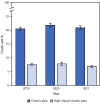Chronic Pain Among Adults - United States, 2019-2021
- PMID: 37053114
- PMCID: PMC10121254
- DOI: 10.15585/mmwr.mm7215a1
Chronic Pain Among Adults - United States, 2019-2021
Abstract
Chronic pain (i.e., pain lasting ≥3 months) is a debilitating condition that affects daily work and life activities for many adults in the United States and has been linked with depression (1), Alzheimer disease and related dementias (2), higher suicide risk (3), and substance use and misuse (4). During 2016, an estimated 50 million adults in the United States experienced chronic pain, resulting in substantial health care costs and lost productivity (5,6). Addressing chronic pain and improving the lives of persons living with pain is a public health imperative. Population research objectives in the National Pain Strategy, which was released in 2016 by the Interagency Pain Research Coordinating Committee, call for more precise estimates of the prevalence of chronic pain and high-impact chronic pain (i.e., chronic pain that results in substantial restriction to daily activities) in the general population and within various population groups to guide efforts to reduce the impact of chronic pain (3). Further, a 2022 review of U.S. chronic pain surveillance systems identified the National Health Interview Survey (NHIS) as the best source for pain surveillance data (7). CDC analyzed data from the 2019-2021 NHIS to provide updated estimates of the prevalence of chronic pain and high-impact chronic pain among adults in the United States and within population groups defined by demographic, geographic, socioeconomic, and health status characteristics. During 2021, an estimated 20.9% of U.S. adults (51.6 million persons) experienced chronic pain, and 6.9% (17.1 million persons) experienced high-impact chronic pain. New findings from this analysis include that non-Hispanic American Indian or Alaska Native (AI/AN) adults, adults identifying as bisexual, and adults who are divorced or separated are among the populations experiencing a higher prevalence of chronic pain and high-impact chronic pain. Clinicians, practices, health systems, and payers should vigilantly attend to health inequities and ensure access to appropriate, affordable, diversified, coordinated, and effective pain management care for all persons (8).
Conflict of interest statement
All authors have completed and submitted the International Committee of Medical Journal Editors form for disclosure of potential conflicts of interest. No potential conflicts of interest were disclosed.
Figures

References
-
- Interagency Pain Research Coordinating Committee. National Pain Strategy: a comprehensive population health-level strategy for pain. Washington, DC: US Department of Health and Human Services, National Institutes of Health; 2016. https://www.iprcc.nih.gov/node/5/national-pain-strategy-report
MeSH terms
LinkOut - more resources
Full Text Sources
Medical
Miscellaneous

